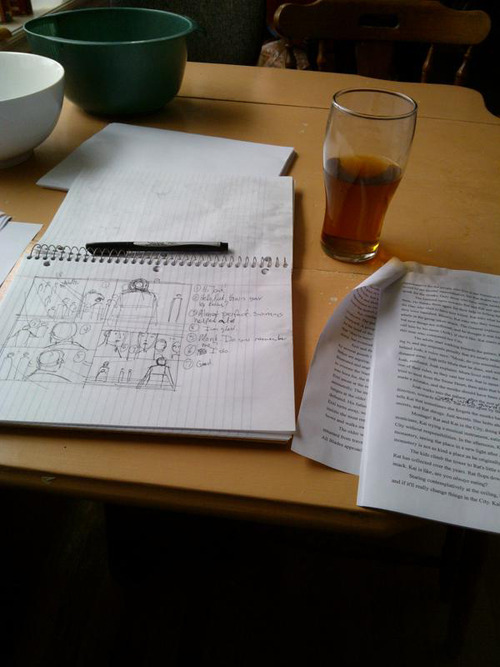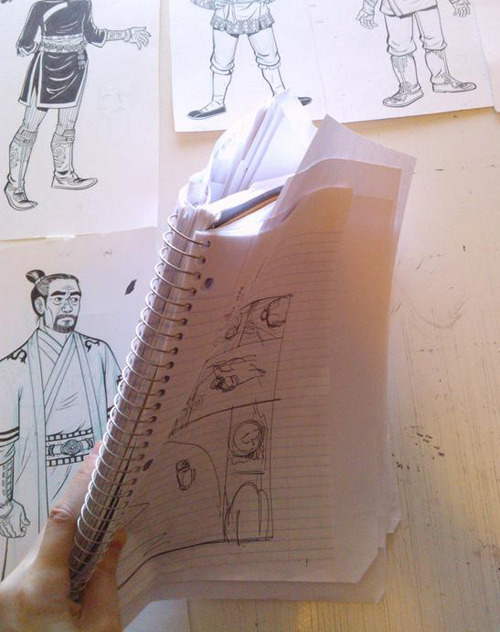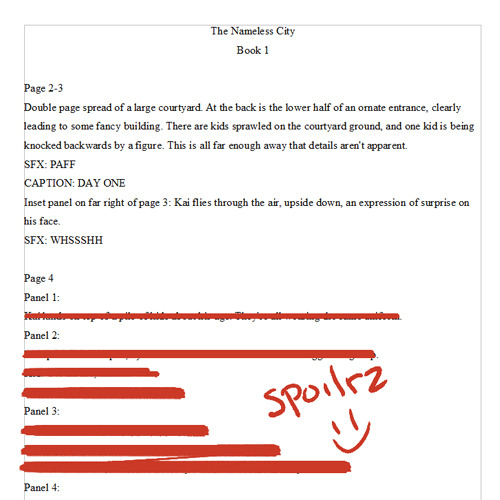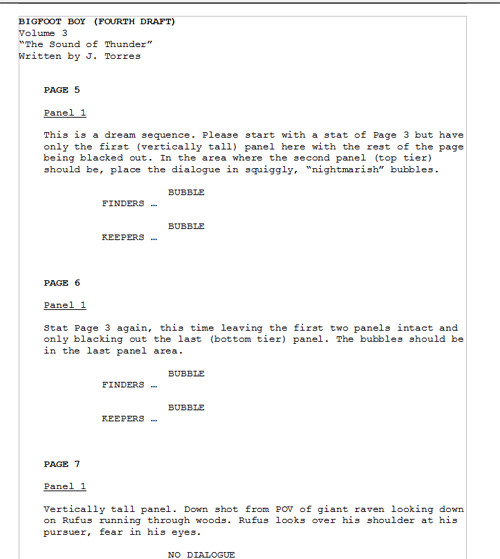nirwastir asked: Hi Faith! I saw what you wrote on hours spent on writing vs. drawing comics and I realized I’ve never actually seen a comic book script before. Does it look like a movie script? Could you tell us a bit about what scripting a comic is like?
I started writing the script for Nameless City book 2 this week, so I am totally prepared to talk about this!
DISCLAIMER! I’m going to give you a peek into how I write comics. This is a method that works for me, but it may not work for you. You don’t have to write this particular way, this is just how I do it. I’m friends with many people who work in the comic book industry and what I’ve discovered by talking to them about process is that we all make comics differently.
So, this is me, working away on the script for Nameless City book 2 this week:

(Your bowls, kitchen table and beverage choice may vary.) The typed pages on the right are my outline. For me, an outline is important. It’s how I keep track of what needs to happen in the story. Mine tend to also have emotional beats (Kai is feeling angry because [reason], Rat is hungry because she’s always hungry) and some important dialogue thrown in. On the left is a spiral notebook purchased from a drugstore. That’s where I draw my rough draft of the book. When making my first draft of a graphic novel, I thumbnail and write dialogue by hand beside the thumbnails.
Why? Because this allows me to think about the artwork and pacing of the comic while writing dialogue. Comics are both art and writing (one does not take precedence before the other), and this thumbnail-and-script method allows me to keep the balance of both at the beginning.
When I’m done my very rough thumbnail draft, I end up with something that looks like this:

lol! That’s the first draft of The Nameless City book 1. All the loose paper is scenes I’ve added or altered, and I wasn’t able to fit them into the spiral notebook. If I was smart, I’d do these early drafts on loose paper or notebooks that allow you to add and remove pages, but I dunno, I just like these cheap spiral notebooks for some reason. XD
Then, when I’m satisfied with this early draft of the comic, I go and type the whole sucker up. It looks approximately like this:

So here’s where we get into the whole thing of “I am both the writer and artist of this comic, so I work a little differently than if I was just the writer.” As both the writer and artist, I have a mental picture of what will be going on in each scene in my head (I’ve also done those thumbnails). So I’m not very detailed when describing what’s going on in each panel. I tend to include only basic, important information in addition to the dialogue, so my editor can understand what’s going on.
In contrast, here’s a page from the script for Bigfoot Boy 3, a kids’ comic series I did with the writer J. Torres. J, by the way, is an experienced and skilled writer, and very good to work with. As an artist, I recommend him!

J is a LOT more detailed in his writing than I am, and there’s a reason for that: he’s not the artist of the comic, I am. And I can’t see into his head. So he has to effectively communicate what he wants drawn in each scene. That’s super important! J also formats his pages properly, which is something I can’t be bothered with if I’m writing for myself (my editor at First Second doesn’t seem to mind). I believe this is a format you can get from that writing program Final Draft (which I do not own but should probably buy at some point). I do all my writing in Open Office, a free program.
So that’s pretty much it, I think! I do a bit of revising when I type up my script, tightening the dialogue and just trying to give things a final polish, and then I hand it into my editor. She gets back to me with notes, we revise, and then I’m off to draw the sucker.
